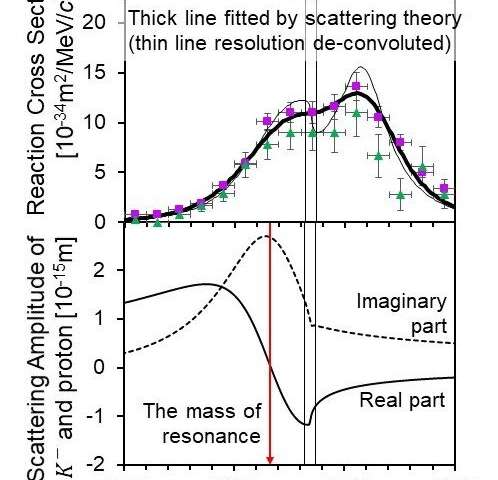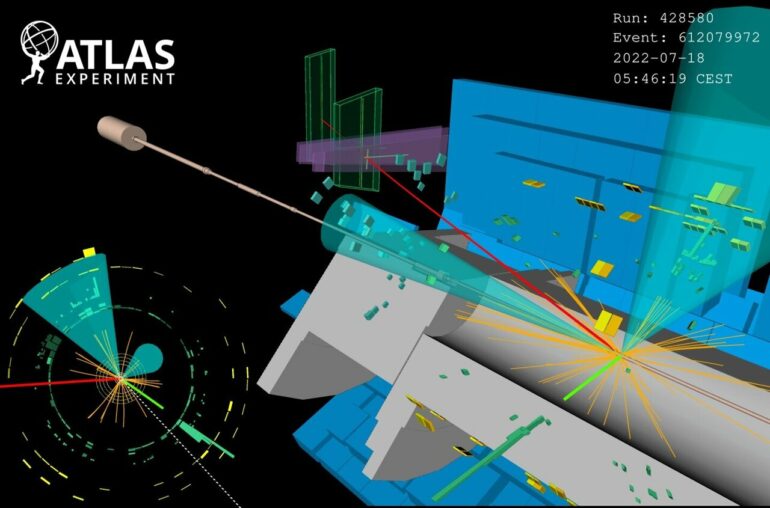The standard model of particle physics tells us that most particles we observe are made up of combinations of just six types of fundamental entities called quarks. However, there are still many mysteries, one of which is an exotic, but very short-lived, Lambda resonance known as Λ(1405). For a long time, it was thought to be a particular excited state of three quarks—up, down, and strange—and understanding its internal structure may help us learn more about the extremely dense matter that exists in neutron stars.
Investigators from Osaka University were part of a team that has now succeeded in synthesizing Λ(1405) for the first time by combining a K– meson and a proton and determining its complex mass (mass and width). The K− meson is a negatively charged particle containing a strange quark and an up antiquark. The much more familiar proton that makes up the matter that we are used to has two up quarks and a down quark. The researchers showed that Λ(1405) is best thought of as a temporary bound state of the K– meson and the proton, as opposed to a three-quark excited state.
In their study published recently in Physics Letters B, the group describes the experiment they carried out at the J-PARC accelerator. K− mesons were shot at a deuterium target, each of which had one proton and one neutron. In a successful reaction, a K− meson kicked out the neutron, and then merged with the proton to produce the desired Λ(1405).
“The formation of a bound state of a K–meson and a proton was only possible because the neutron carried away some of the energy,” says Kentaro Inoue, an author of the study. One of the aspects that had been perplexing scientists about Λ(1405) was its very light overall mass, even though it contains a strange quark, which is nearly 40 times as heavy as an up quark. During the experiment, the team of researchers was able to successfully measure the complex mass of Λ(1405) by observing the behavior of the decay products.

Schematic illustration of the reaction used to synthesize Λ(1405) by fusing a K– (green circle) with a proton (dark blue circle), which takes place inside a deuteron nucleus. © Hiroyuki Noumi

(Top) Measured reaction cross-section. The horizontal axis is the K– and proton collision recoil energy converted into a mass value. Large reaction events occur at mass values lower than the sum of the K– and proton masses, which itself suggests the existence of Λ(1405). The measured data were reproduced by scattering theory (solid lines). (Bottom) Distribution of K– and proton scattering amplitudes. When squared, these correspond to the reaction cross-section, and are generally complex numbers. The calculated values match with the measured data. When the real part (solid line) crosses 0, the value of the imaginary part reaches its maximum value. This is a typical distribution for a resonance state, and determines the complex mass. The arrows indicate the real part. © 2023, Hiroyuki Noumi, Pole position of Λ(1405) measured in d(K^-,n)πΣ reactions, Physics Letters B
“We expect that progress in this type of research can lead to a more accurate description of ultra-high-density matter that exists in the core of a neutron star,” says Shingo Kawasaki, another study author.
This work implies that Λ(1405) is an unusual state consisting of four quarks and one antiquark, making a total of five quarks, and does not fit the conventional classification in which particles have either three quarks or one quark and one antiquark. This research may lead to a better understanding of the early formation of the universe, shortly after the Big Bang, as well as what happens when matter is subject to pressures and densities well beyond what we see under normal conditions.
More information:
S. Aikawa et al, Pole position of Λ(1405) measured in d(K−,n)πΣ reactions, Physics Letters B (2022). DOI: 10.1016/j.physletb.2022.137637
Citation:
Particle accelerator experiment creates an exotic, highly unstable particle and measures its mass (2023, January 26)
